| In Venice Today.com |
|
||
|
|
|||||||||||||||||||||||||||||||||||
|
|||||||||||||||||
Ca' Rezzonico Museum of VeniceThe Ca' Rezzonico Museum in Dorsoduro Venice: history, opening hours, contacts, fares of tickets and useful information for the visit. |
|||||||||||||||||
|
|||||||||||||||||
|
|||||||||||||||||
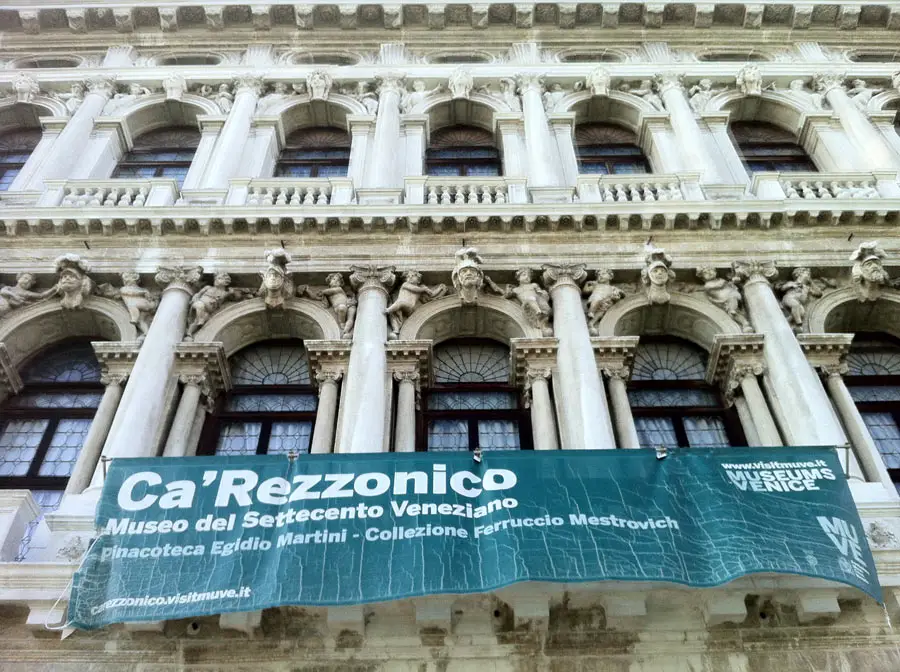 Ca' Rezzonico Museum - Dorsoduro 3136 - Venice The Ca' Rezzonico Civic Museum is located inside the Dorsoduro district, overlooking the right bank of the Grand Canal not far from Ca' Foscari and the Accademia Museums. It houses Venetian interior reconstructions and a collection of 18th-century Venetian painting where some of Canaletto, Longhi and Tiepolo are housed. The Ca' Rezzonico Museum is open from 25 April 1936 and there are numerous art exhibitions organized throughout the year.  As you enter you can admire on the right a historical gondola with felze, the typical cover used until the nineteenth century in Venice to ensure the privacy of the illustrious guests ferryed by the well-known boats. On the ground floor a large entrance hall leads to the small space that overlooks the Grand Canal. Here, from the staircase located next to the cafeteria, we pass to the Browning Mezzanine which houses the Mestrovich Collection with works by Jacopo Tintoretto, Benedetto Diana, Bonifacio de 'Pitati, Lelio Orsi, Francesco Guardi, Jacopo Amigoni and Alessandro Longhi. Also from the entrance hall on the ground floor, through the grand staircase of honor designed by Giorgio Massari, we reach the first floor where the official route of the Ca' Rezzonico Museum begins. The Ca' Rezzonico Museum is composed on the first floor of eleven rooms that house paintings and sculptures; but also faithful reconstructions of the Venetian nobility: taking advantage of the fresco decoration of the ceilings and the arrangement of furniture and furnishings of the time, the result is surprising. On the first floor, in addition to the impressive dance hall, you can admire notable paintings such as the Portrait of Francesco Falier as Procuratore da mar by Bernardino Castelli (1786) or the Fresco Allegory of Giambattista Tiepolo (1757) in the second room. In the following rooms there is a fresco signed by Diziani, Flemish tapestries, another fresco by Giambattista Tiepolo depicting the Allegory of Merit and a canvas of the same entitled Nobilt� e Virt� which demolish Perfidia. Moving upstairs you can admire some of the most famous works from the Ca' Rezzonico Museum collection: two paintings by Canaletto, some paintings by Longhi and the frescoes by Giandomenico Tiepolo from Villa Zianigo. The last floor, which offers notable panoramic views over Venice, preserves the Egidio Martini Picture Gallery. Masterpieces of Ca' Rezzonico Museum - Cristo passo by Giambattista Cima da Conegliano - Cristo benedicente by Benedetto Diana - Sacra conversazione by Bonifacio De’ Pitati - Cristo deposto sostenuto da San Giovanni e dalla Maddalena alla presenza di due committenti by Jacopo Tintoretto - Portrait of Francesco Gherardini by Jacopo Tintoretto - Affresco dell'Allegoria Nuziale by Giambattista Tiepolo (1757) - Ritratto di Francesco Falier in veste di Procuratore da mar by Bernardino Castelli (1786) - Ritratto di Clemente XIII Rezzonico by Anton Raphael Mengs (1758) - Orfeo massacrato dalle Baccanti by Gregorio Lazzarini (1698) - Veduta del rio dei Mendicanti by Canaletto - Veduta del Canal Grande da Ca’ Balbi verso Rialto by Canaletto - Affreschi da Villa Zianigo by Giandomenico Tiepolo 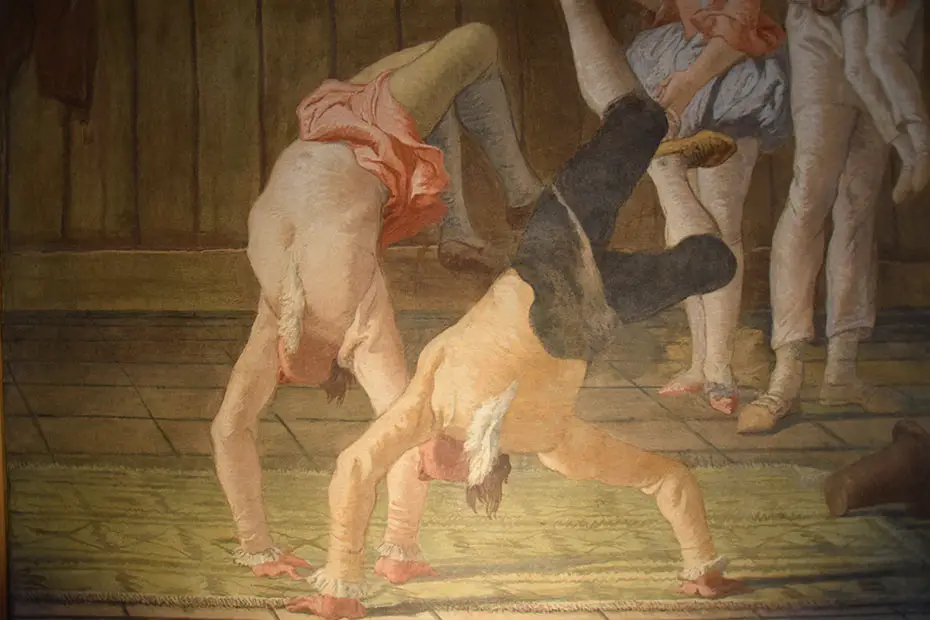 Sculpture - Bust of Lucrezia by Filippo Parodi - Veiled Lady (Puritas) by Antonio Corradini - Dama velata (Puritas) di Antonio Corradini Architecture The Palace has a monumental stone fa�ade of three orders, built on a project by Longhena completed by Giorgio Massari, which overlooks the Grand Canal shortly thereafter. Each level has 7 openings, with a round arch in the second and third levels, interspersed with columns that are transformed on the sides in a twin scheme. The first level - enriched with rusticated decorations and a portal of water to protrude with three doors with architrave that anticipate the three rear entrances to the sixth - has columns in Doric style with windows architraved and human masks on top. The theme of the masks is repeated in the second level with more elegant and slender figures accompanying putti in the sails created by the round arches of the arched windows which are supported by slender ionic columns. Each opening has a stone balustrade and is separated from the adjacent by an Ionic column placed on a base bearing a bas-relief with medallions with vegetal elements. The third level repeats the scheme of the second in the sails of the windows but here the masks are feminine and the columns of the windows are Ionic while the major columns are Corinthian, Thus concludes the typical columnar pattern of the Colosseum in three levels: Doric, Ionic, Corinthian. On the upper level there is the mezzanine mezzanine level decorated with oval single-light windows surrounded by plant motifs and separated by grooved bases which are coupled to the sides of the building. The interior, which is accessed through a small private courtyard, is equally monumental in the vastness of the entrance hall that overlooks the Grand Canal; from here you enter the staircase of honor - embellished by the presence of two statues representing the Winter and Autumn by Giusto Le Court - which leads to the remarkable Sala delle Feste, both designed by Giorgio Massari for the Rezzonico family. Party Hall 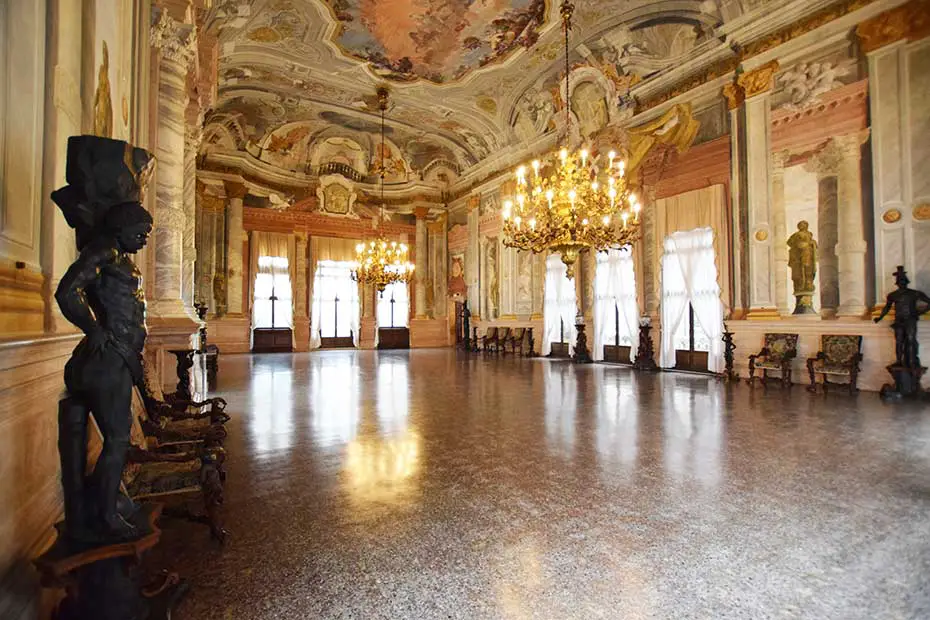 The Hall represents the ambition of the family nova of Rezzonico, who arrived in the city recently but decided to play a leading role in the mighty worldly life of the eighteenth century. It enters through a monumental portal with a round arch on fluted Ionic columns and a key mask with two beautiful Corinthian columns in polychrome marble supporting a trabeation with a tympanum with ribs, interrupted by the presence of a bust on a pedestal. Artists of the parietal decoration were Giambattista Crosato, who had worked as a painter at the court of the Savoy, and Girolamo Mengozzi Colonna, the quadraturist of Giambattista Tiepolo. The walls have false gray pilasters, with central golden medallions and Corinthian capitals also gilded, which frame false painted statues; to create a perspective effect we think of a series of columns in gray marble that supports an architrave in Verona Red Marble that dialogues with the entrance portal. 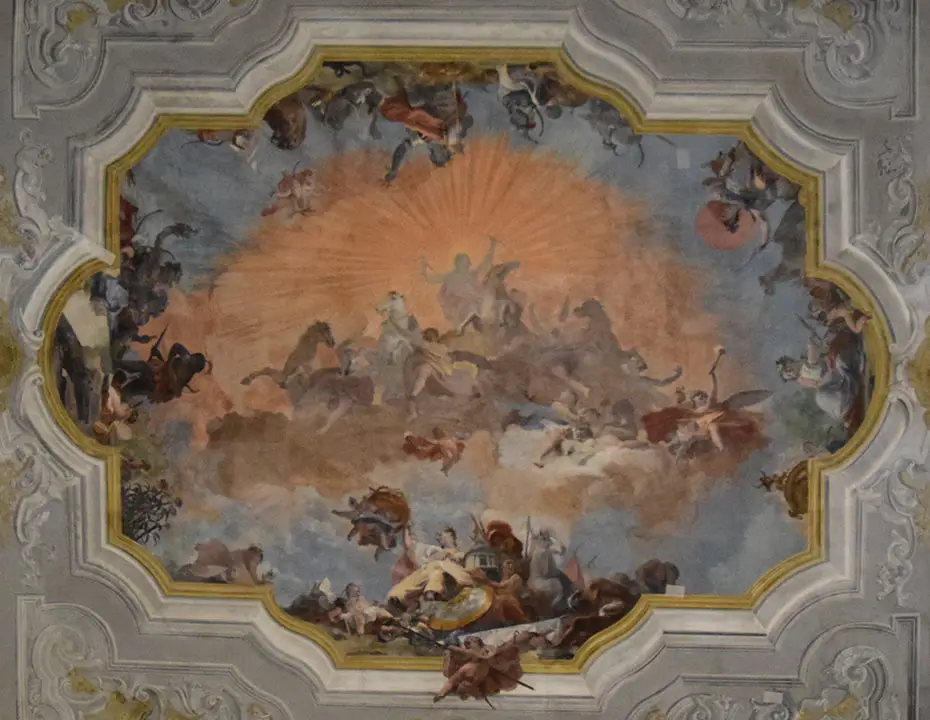 Above the golden frieze and the trabation there are lodges and balconies painted at the corners while, in a golden curvilinear frame, at the center of the ceiling there is Apollo who rises with his chariot to illuminate the four parts of the world (Europe, Asia, Africa , America) impersonated by girls of different races. The two large golden wooden chandeliers are the original ones used for parties. The Ballroom faces the Coat of arms of the Rezzonico in front of the entrance, while biceps eagles (with two heads) of their coat of arms are present on all the capitals. On the ground there are elements of furniture such as statues in ebony and boxwood made by Andrea Brustolon; this is the famous supply Venier (1690-1700), consisting of high chairs for parades and putti, mori and allegories for pot holders. Hall of Bridal Allegory 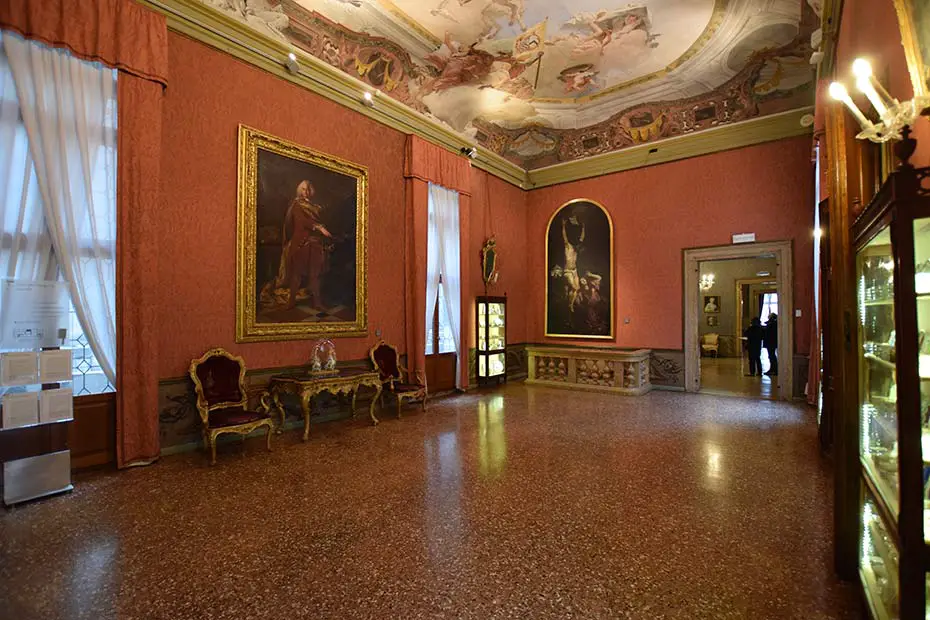 The room takes its name from the marriage celebrated between Ludovico Rezzonico and Faustina Savorgnan in 1757; the following year Giambattista Tiepolo and Girolamo Mengozzi Colonna realized the ceiling fresco of the Bridal Allegory; the two create a strong perspective effect creating an articulated architecture composed of a balustrade behind which stands a wall with Ionic pilasters with niches and compartments ending in a parapet that opens onto the sky. Here, between satyrs and cherubs, the married couple on the chariot of Apollo appears, descending guided by a blindfolded cupid who grabs a torch and a dove. Over the newlyweds, Fame announces her arrival with her trumpet; on the right the Truth with the sun in his hand; on a cloud below are laid the graces that symbolize the joy of living; finally the Merit, an old laurel crown with the emblem of the Rezzonico with a lion at his feet, symbol of San Marco. In this room also three paintings: the Portrait of Francesco Falier as procuratore de Mar by Bernardo Castelli (1786) and Portrait of Carlo Rezzonico, elected Pope Clement XIII in 1758 by Anton Raphael Mengs, a small altarpiece with Madonna and Saints by Francesco Zugno. On the right you can see the hanging chapel overlooking Rio San Barnaba. 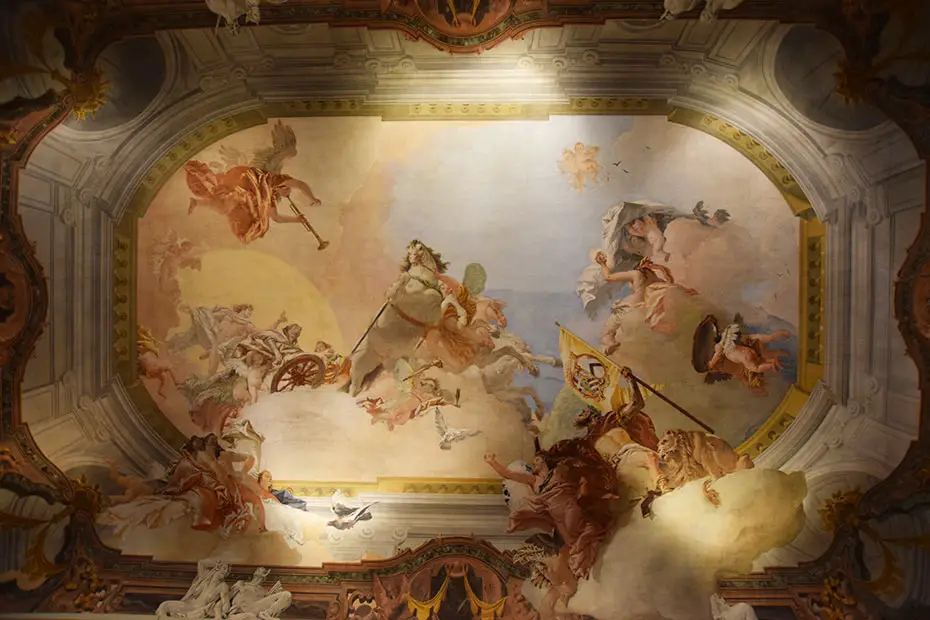 Hall of Pastels 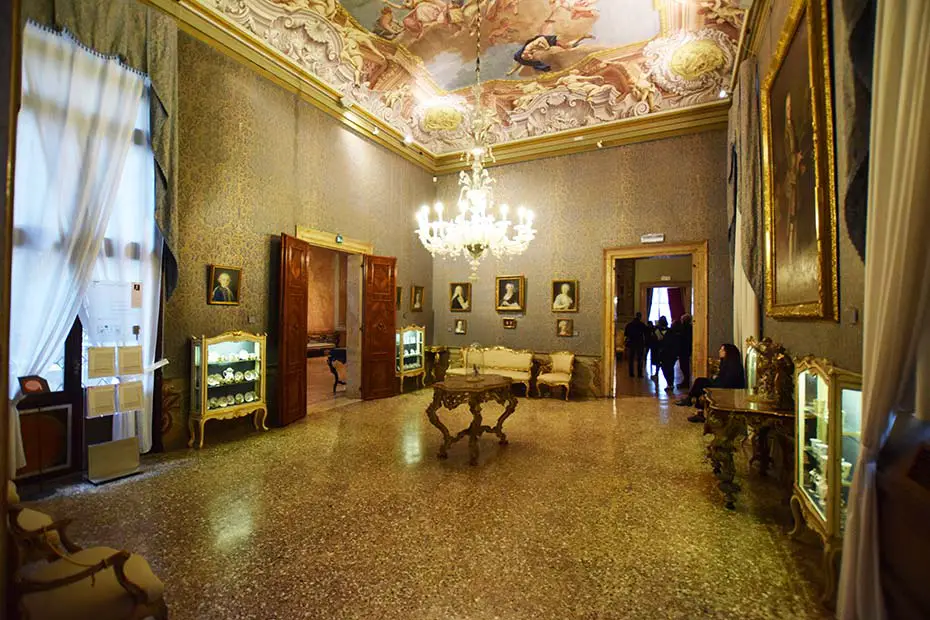 The room - with beautiful Venetian floors and rich wallpaper - takes its name from the collection of portraits of Rosalba Carrera executed in pastel: a Portrait of a Gentleman in Red, Portrait of Faustina Bordoni Hasse, Portrait of Sister Maria Caterina Puppi. There is also a Portrait of Cecilia Guardi by Lorenzo Baldissera Tiepolo, his mother, wife of Giambattista Tiepolo and sister of Francesco Guardi. On the ceiling there is a fresco by Gaspare Diziani, the Triumph of the Arts on Ignorance in which a procession of allegories presents its artistic instrument. Hall of the Tapestries 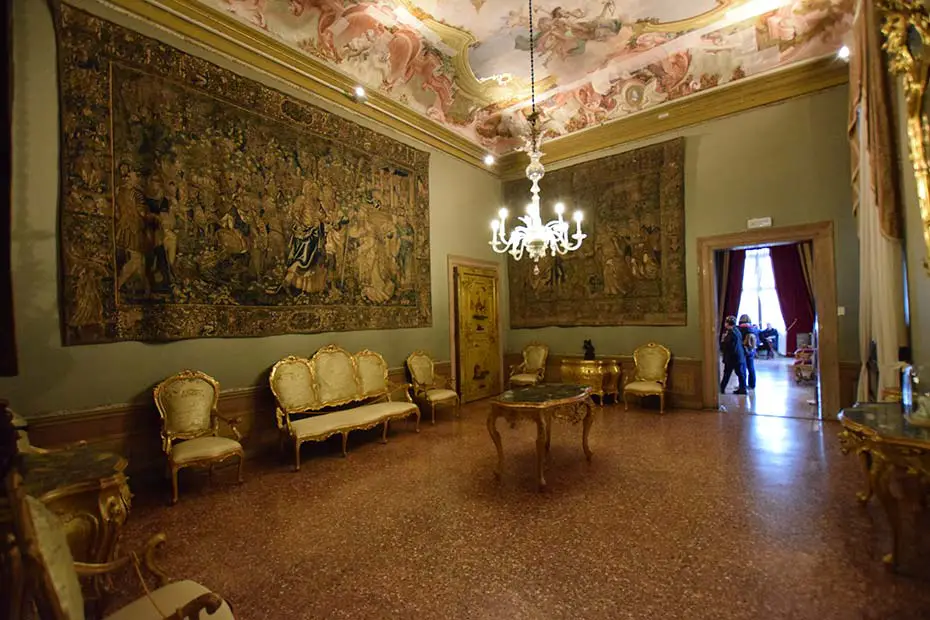 Three seventeenth-century Flemish tapestries with stories about King Solomon and the Queen of Sheba give the name to the room where a fresco by Jacopo Guarana (1757), Tiepolo's artistic heir, left for Madrid, stands out on the ceiling. The underlying frame is the work of Piero Visconti; at the corners are placed the theological virtues, in the middle are the Temperance with the bridles, the Fortezza below with helmet and shield, the Marital Concordia and the Value with lion at the top. Left to see Justice and Prudence; at the top the Eternity with the sun and the moon, finally on the left the Abundance and the Glory. The room then presents original pieces of furniture from the eighteenth century, such as tapestries, from the Balbi Valier palace to Santa Maria Formosa. Throne Hall 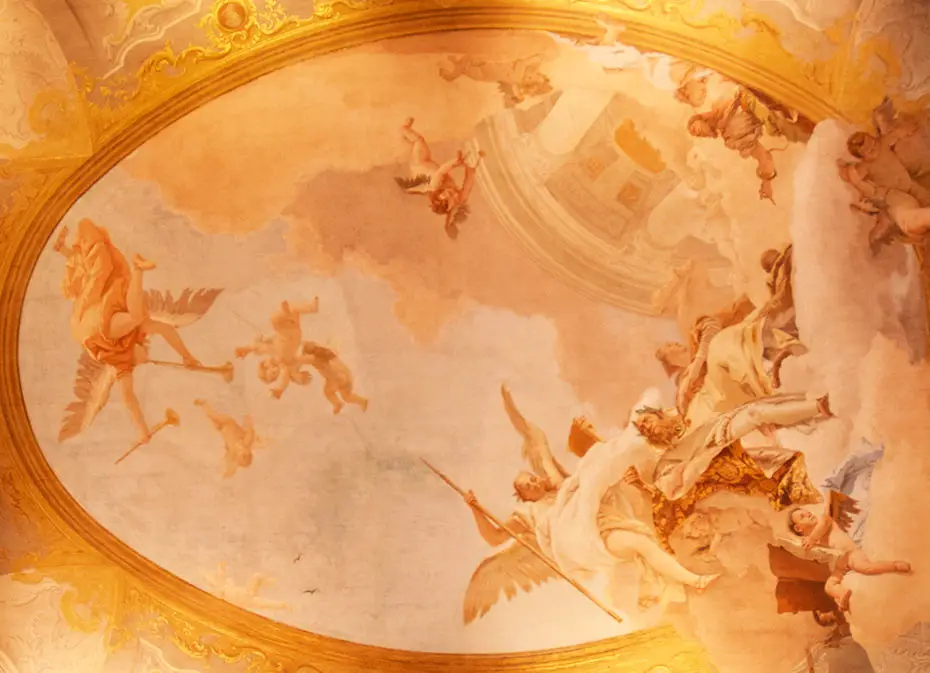 Here we find an allegorical fresco, signed by Giambattista Tiepolo and Girolamo Mengozzi Colonna, which represents Merit, also shown here as an old bearded crowned laurel, together with Nobility, winged with spear in hand, to Virtue on the right, ascending to the Temple of Immortal glory. Under the Merit a figure holds the golden book of the Venetian nobility that since 1687, after a payment of 100,000 ducats, also included the Rezzonico. The Throne that gives its name to the room - red velvet upholstered with Venetian floors - is the one used in the stop in Chioggia - on a journey from Rome to Paris - by Pius VI on March 10, 1782. It is a work of the early eighteenth century with rich golden decoration with nereids, sea horses and cherubs. On the wall there is a Portrait of Pietro Barbarigo of Castelli Bernardino with a very rich allegorical golden frame representing Love for the country, Charity, Constance, Magnanimity, Prudence, Justice, Faith. Tiepolo Hall 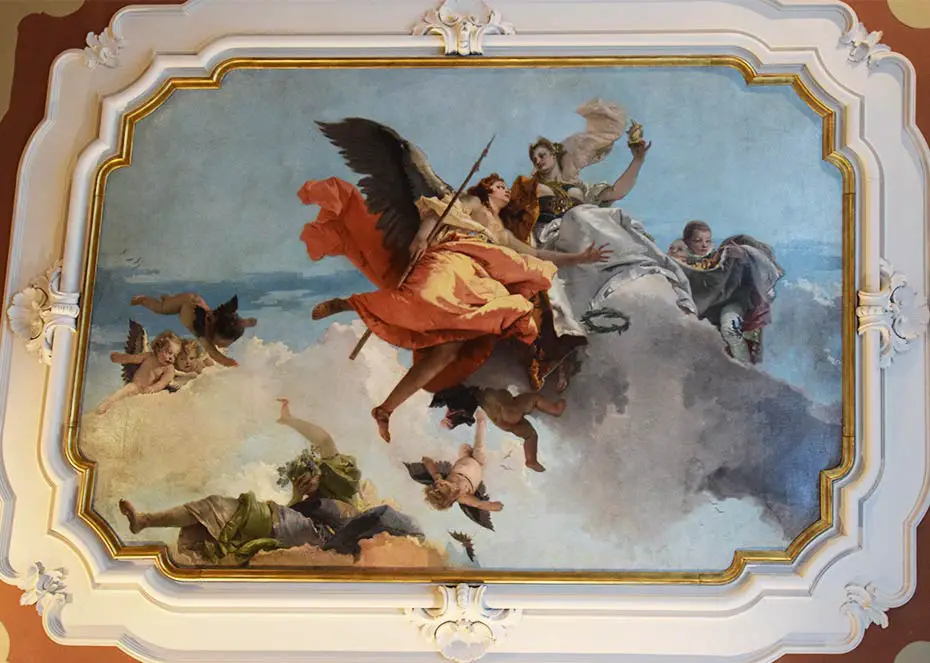 Here is the Nobility and the Virtue that knock down the Ignorance (1744-1745), once in Palazzo Minotto-Barbarigo of Santa Maria del Giglio and purchased in 1934 by the City of Venice who decided to take it to Ca 'Rezzonico. The theme represented was very dear to the eighteenth-century noble society. In the room are exposed Portrait of the architect Bartolomeo Ferracina by Alessandro Longhi, son of Pietro, and two ovals of a young Giambattista Tiepolo (1715). The furniture is made up of a wooden baroque playing table, with eight legs with a lion's paw and a green cloth shelf, and eight boxwood armchairs from the workshop of Andrea Brustolon, once belonging to the Correr. 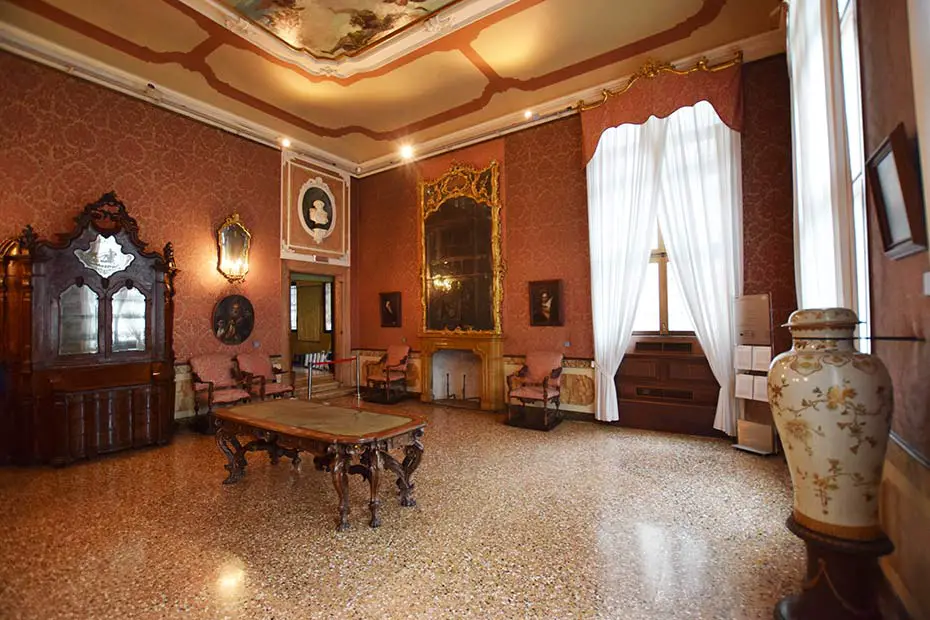 Library or Sala Morlaiter The room contains sketches and models in terracotta and terracruda by Giovanni Maria Morlaiter (1699-1781). The collection, purchased by the city of Venice in 1934, shows the creative process of one of the greatest interpreters of 18th-century sculpture, author of innumerable statues and altars in more than 20 churches and basilicas in the city. Alongside his models are those of his friends and colleagues like Just Le Court and Heinrich Meyring, naturalized Flemings known in the city as Giusto Le Court (1627-1679) and Enrico Merengo (1638-1723). The wooden frame of the ceiling crowns another Allegory of Merit by Mattia Bortoloni (1695-1750), the same one that frescoes the domes of the Church of the Tolentini. Morlaiter Hall 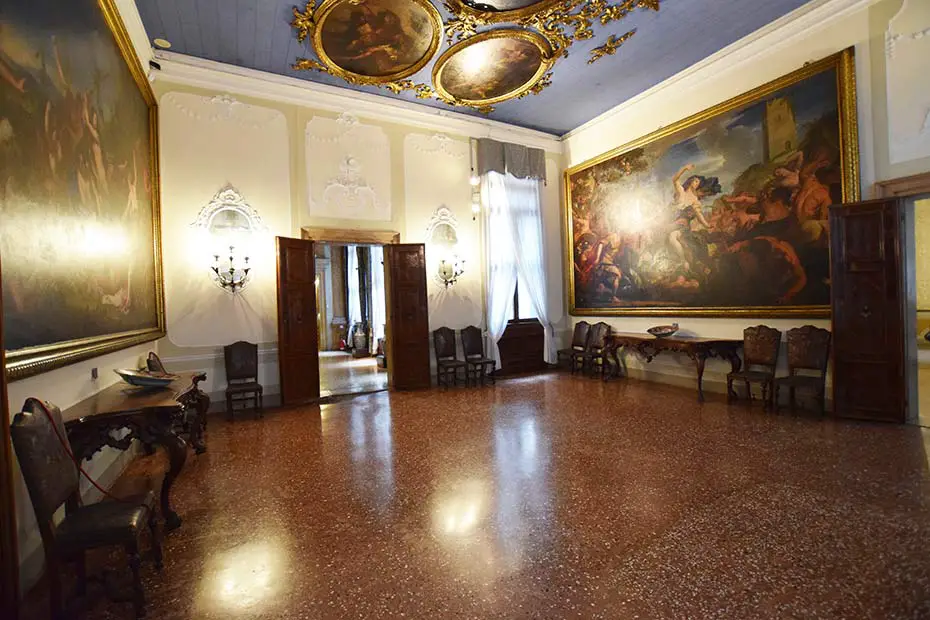 The hall houses three large paintings including Orfeo torn by the Bacchaeos by Gregorio Lazzarini (1657 - 10 November 1730), best painter of his time and trainer in his workshop of the talent of Giambattista Tiepolo from 1716. The other two paintings are a Battle between Centauri and Lapiti by Antonio Molinari (1655-1704) and an Ercole and Onfale by Antonio Bellucci (1654-1726), both protagonists in Europe and in Venice during the Baroque period together with Lazzarini. The 5 ovals in gilded ceiling frames are by Francesco Maffei (1605-1660) and come from Palazzo Nani on the Rio di Canaregio. The curiosity lies in the decoration with oval paintings on the ceiling that was typical of the seventeenth century and ended with the advent of the fresco. The ovals represent Daedalus and Icarus, Perseus and Andromeda, Prometheus freed from Hercules, Prometheus, Perseus showing Atlas the head of Medusa. In the center of the room there is a seventeenth-century writing desk, covered with ivory woods and inlays, a masterpiece by Pietro Piffetti (1741). Sala Brustolon 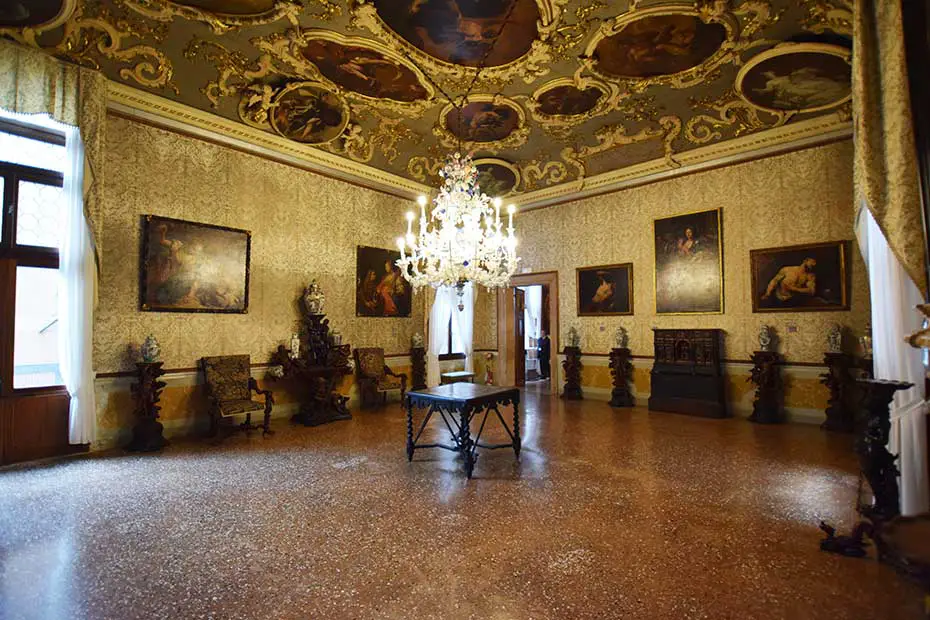 These findings also come from Palazzo Nani in Rio di Cannaregio. It is always the Fornitura Venier (1690-1700), a masterpiece of baroque cabinetmaking as can be appreciated from the Hercules winner of the Hydra of Lerna and Cerbero placed inferiorly in the splendid vase holder that Venier commissioned for his collection of oriental vases. The cycle of works by Francesco Maffei from the previous room continues on the ceiling, once at Palazzo Nani in Canaregio; here are 11 paintings depicting Jupiter in the center and around him Saturn, the Tact, Venus, Mars, Diana, Mercury, Apollo; externally we see Minerva, the Hearing, the Divine Wisdom. Alongside this cycle, in the corners of the ceiling, there are 4 monochromatic rounds by Francesco Polazzo (1683-1753). All the paintings are lit by a flaming crystal chandelier with polychrome floral decoration, by Giuseppe Briani. Portico 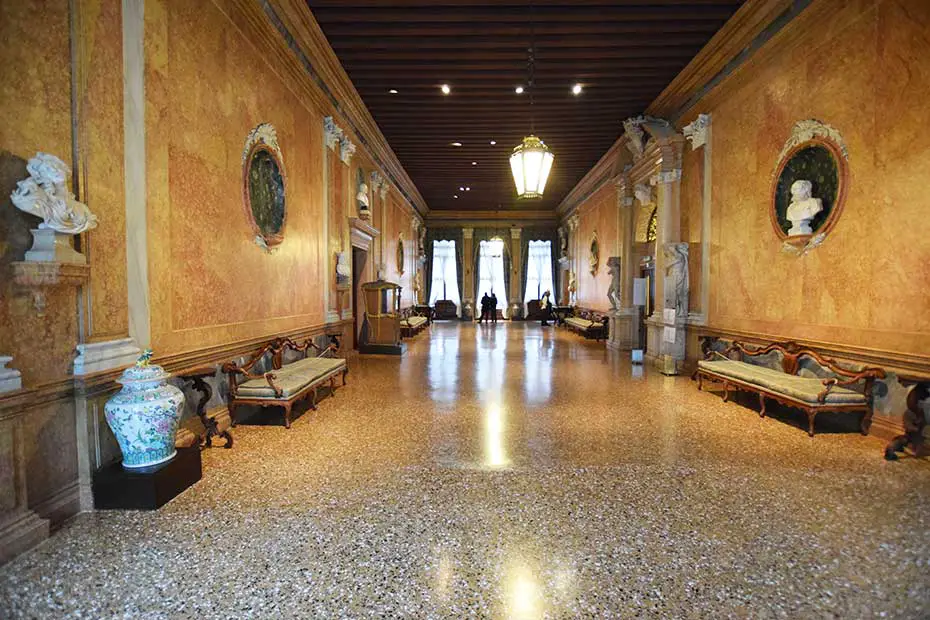 The Portico, built on a project by Longhena and then taken over by Massari, was the hall of representation once decorated with paintings by Luca Giordano (1634-1705) and then sold in the nineteenth century. Here, between a wooden ceiling with dense truss and a polychrome Venetian floor, there are walls in pink marble decorated on the sides of the doors by double Corinthian pilasters with busts in the middle while circular niches - above the doors and in the center of the walls - make the pair also hosting eighteenth-century marble busts. You can admire the Envy of Just Le Court (1627-1679) presented as a decrepit old woman with snakes in her hair, a Lucrezia by the Genoese baroque sculptor Filippo Parodi (1630-1702). The decor of the room has sofas in typical French rocaille style, carved walnut trestles and an elegant golden sedan chair, complete the furniture. The monumental portal presents Ionic columns on bases supporting trabeation and tympanum with ribs interrupted by the presence of the Rezzonico coat of arms. On the sides of the portal there are two sculptures by Alessandro Vittoria (1525-1608) that once served as telamones in a sixteenth century fireplace. Portego of the Paintings 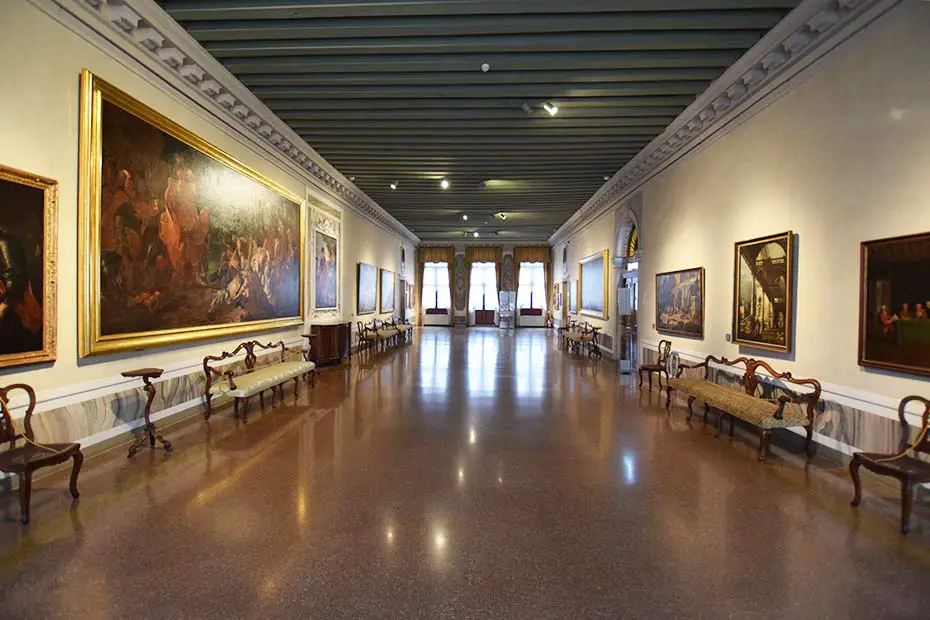 Passed upstairs you enter the corresponding hall of the porch just left. Here are some of the most significant paintings of the Ca 'Rezzonico Collection: The diplomatic conference of Francesco Guardi The death of Dario by Giambattista Piazzetta The Grand Canal from Palazzo Balbi to Rialto, Rio dei Mendicanti by Antonio Canal known as Canaletto The Feast of Santa Marta by Gaspare Diziani Giandomenico Tiepolo in Zianigo 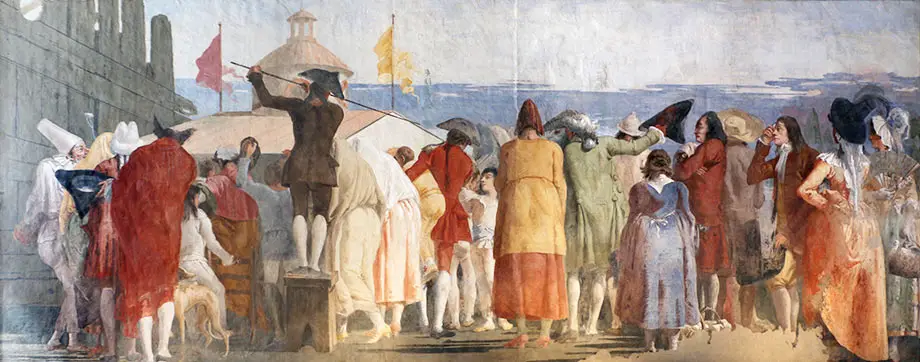 The rooms host the frescoes made by Tiepolo for his Villa di Zianigo. The works were taken away in 1906 to be sold but the City of Venice managed to buy them and lodge them at Ca 'Rezzonico in 1935; here the original collocations have been reproduced. Created between the years 1759 and 1797, they cover a great span of the master's career and are a unique opportunity to admire the personal taste of Tiepolo, here freed up by all clients. One can appreciate Rinaldo abandoning the garden of Armida, subject of Torquato Tasso's Gerusalemme Liberata; a Falchetto that falls on the flock of fleeing sparrows; the revolutionary Il Mondo Novo where a crowd is gathered around a wooden box to see exotic images from America known as Mondo Novo. Continuing we appreciate the walk in the villa, Minuetto and the splendid Stanza dei Pulcinella; the figure of the Neapolitan mask of Pulcinella, mocking populace of the powerful, we see here behave like the nobles portrayed before, foreshadowing a less elegant and more irreverent modernity that was about to change society forever: critics date the end of the cycle to 1797, Fall of the Serenissima. Hall of the Harpsichord  A harpsichord placed in the center of the room gives it its name; the instrument dates back to the middle of the seventeenth century, while the case that contains it is from the mid-eighteenth century and is embellished with the technique of "poor lacquer" in which prints were glued and then passed with a transparent lacquer. In the display cases on the walls there is a collection of porcelains dating back to the eighteenth century. Porcelain, born in China during the Tang Dynasty (7th century AD), arrived in Europe and Venice as early as the 12th century but, known as white gold, the secrets of production were ignored. Until 1707 when in Meissen, at the court of Augustus the Fort, the technique was understood. In Venice in 1720 he opened the Vezzi and then the Cozzi, followed by Ginori in Tuscany in 1735 and that of Capodimonte in 1738, which was opened by Charles of Bourbon married Maria Amalia of Saxony, nephew of Augustus the founder Forte of Meissen. The exhibits exhibited in the room come from these productions that knew a huge success in the eighteenth century; the porcelain gave the possibility to build the daring lines of the Rococo that embodied the spirit of the era. Parlor Hall  The room presents the usual Venetian floors and ceiling with frescoes, torn Palazzo Nani di Canaregio, the conjugal Concordia crowned by Virtue in the presence of Justice, Prudence, Temperance, Fame, the Abundance by Costantino Cedini (1741-1811), student of Giambattista Tiepolo, with seventeenth-century frame by Antonio Felice Ferrari (1667-1811). The present furniture comes from Palazzo Calbo Crotta ai Scalzi: you can see a chest of drawers with a curved profile underneath a large mirror with a golden frame, two rocaille style bedside tables, numerous armchairs with eighteenth-century arm rests. But it is Francesco Lazzaro Guardi (1712-1793) who gave the hall its name through his painting The Parlatorio delle monache di San Zaccaria, which is always associated with his painting Il Ridotto by Palazzo Dandolo in San Mois�. The latter was a famous place in the city and a destination for every visitor to Venice; a state gambling hall opened during the Carnival which at the time began on December 26th. Sala Longhi 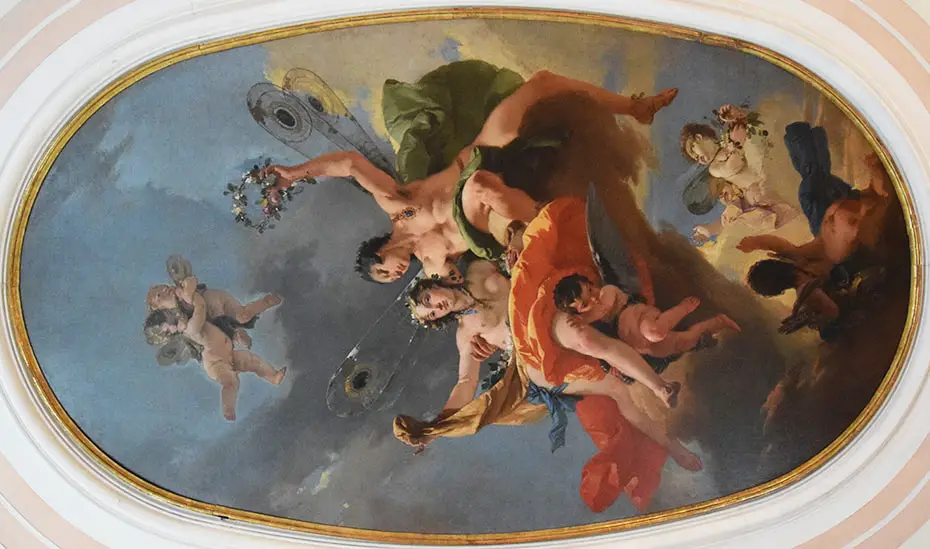 The room traces the pictorial career of Pietro Longhi (1701-1785), from a religious and mythological painter to a genre painter, portraitist of shepherds and peasants and commoners who are seen in Polenta and Furlana. Chronologically successive paintings such as La Cioccolata del mattino, Il parrucchiere, The Visit of a Knight in Bauta, La Lettera del Moro portray the Venetian patricians during their daily life in their sumptuous palaces, and it is a new genre in Venice which will give the Longhi undying fame. Alongside the private portraits also the portraits of the masked nobles - so by law they had to circulate in the city - at Carnival, like Il Rinoceronte, a work commissioned in 1751 by Giovanni Grimani, as the cartouche says, on the occasion of the arrival in San Marco of a Bengali rhinoceros named Clara. The ceiling hosts a work by Giambattista Tiepolo painted for the marriage between Antonio Pesaro and Caterina Sagredo (1732): it is Zefiro and Flora that once stood in Palazzo Pesaro. Here Flora, who personifies Nature and therefore life awakens to the arrival of Zephyr in the spring months. Here too, as for the previous room, the yellow lacquered furniture with flower decorations and red curls, which match with the upholstery on the walls, come from Palazzo Calbo Crotta. Hall of the Green Lacquer 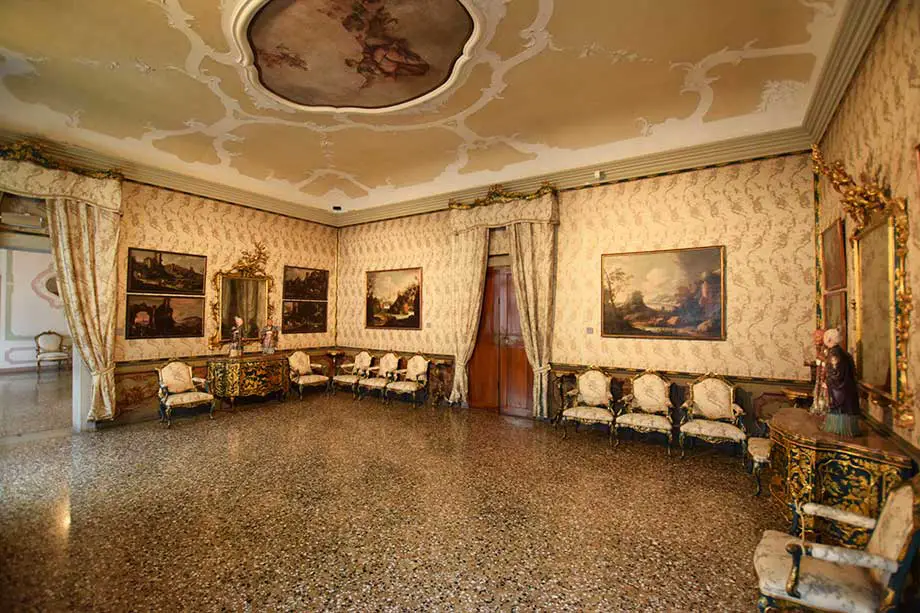 The room houses furniture that always belonged to Palazzo Calbo Crotta in Cannaregio; they are splendid specimens in rocaille style in green lacquered with scenes painted in gold with an exotic character, according to the taste of the time. Above the cabinet there are two polychrome oriental statues in porcelain and the mirror with a large crest. Actually the exotic polychrome figures in painted terracotta, with moving heads, are of exotic provenance. The ceiling houses the Triumph of Diana, by Antonio Guardi (1699-1760), Francesco's brother, once at Palazzo Barbarigo Dabal�. Sala Guardi 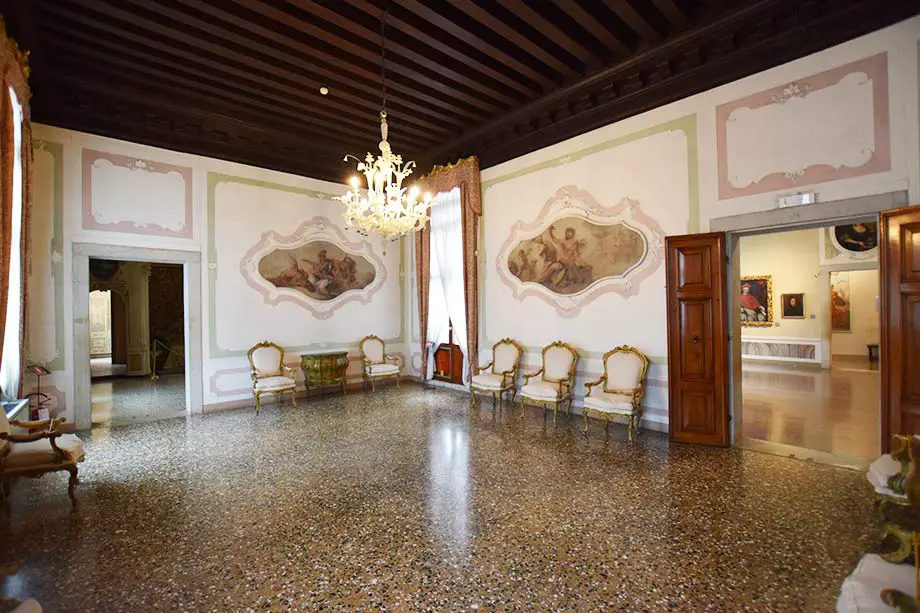 The hall continues the study of the work of Antonio Guardi with the presence of the frescoes once in Palazzo Barbarigo Dabal� and moved here to the opening of the museum (1936). One sees a Minerva, an Apollo and a Venus and Love. The bust of the Dama Velata is the work of Antonio Corradini (1688-1752), an expert artist of veiled subjects who in fact ended his life in Naples in the Sansevero Chapel where he sculpted Pudicizia. The 1770 furniture includes typically curvilinear rocaille armchairs and two lacquered green drawers with a floral decoration. Alcove 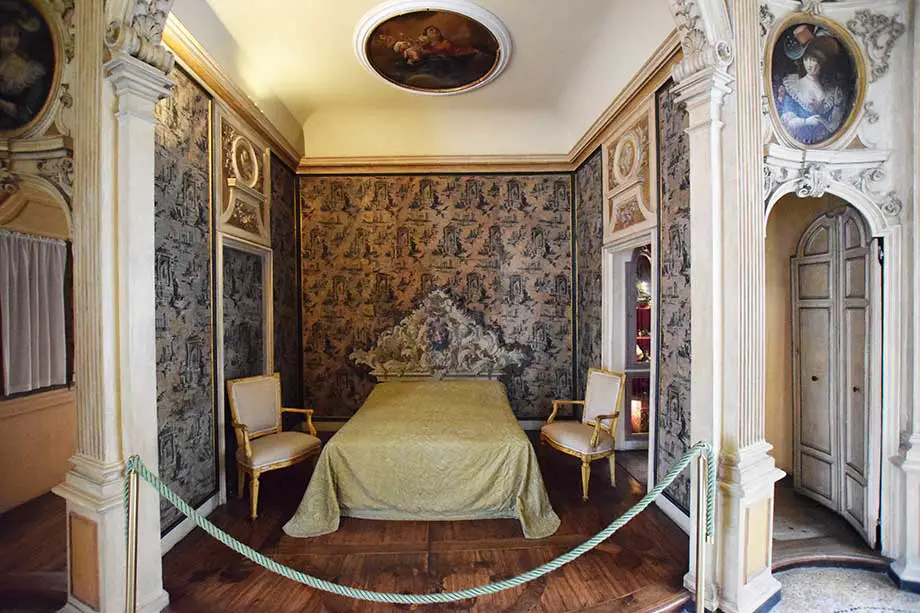 The room offers a reconstruction of a typical 18th century noble bedroom. But the furniture is original and comes from Palazzo Carminati in San Stae. Here, a wooden structure opens into a round-shaped door with Ionic pilasters that externally change into fluted corinthians. The room is embellished with pictorial tondi, while the bed has a Holy Family with Sant'Anna and San Giovannino in the headboard and a Madonna of Rosalba Carriera above it. A bureau trumeau and a crib in lacquered green with floral decoration complete the decor with polychrome flowers. Inside a showcase there is a toilet belonging to the Pisani Moretta family who dates back to 1752, the year of marriage between Cattaruzza Grimani and Pietro Vettor Pisani. There are 58 pieces in green onyx and gilded silver that unveil the elegance of an eighteenth-century noblewoman. The boudoir has 18th century stuccoes and paintings by Costantino Cedini (1741-1811). Pharmacy Ai Do San Marchi 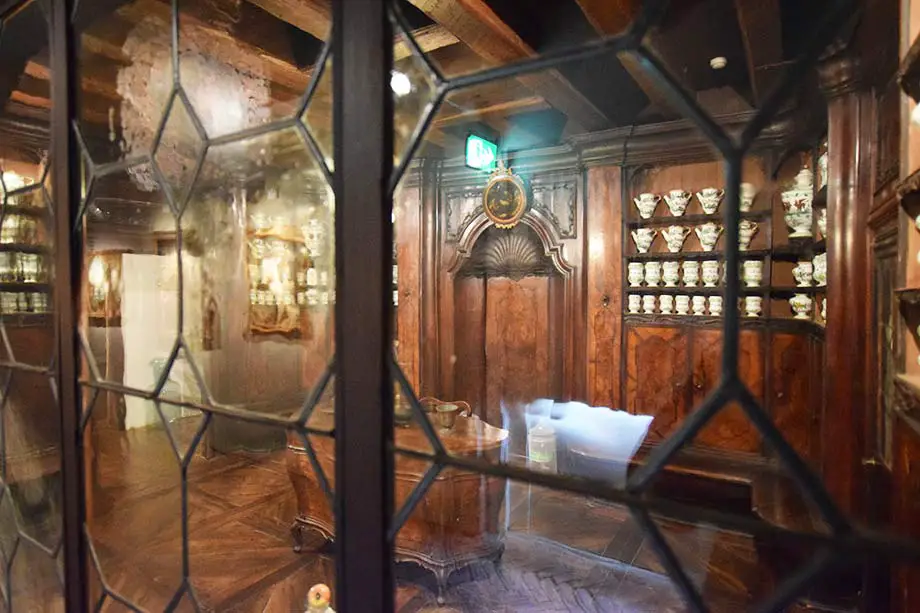 Going to the upper mezzanine is the Ai Do San Marchi Pharmacy, once active in San Stin in Venice at least since 1679 and conferred in the Collection of Venetian Civic Museums in 1908. The receptacles are the work of the Cozzi, producers in Venice of porcelain and majolica since 1630 In the dark walnut briar furniture there are containers with medicines, in the second space the Murano glass stills with fireplace and stove, the third space contains mortars and vases of white majolica. Egidio Martini Pinacotheca 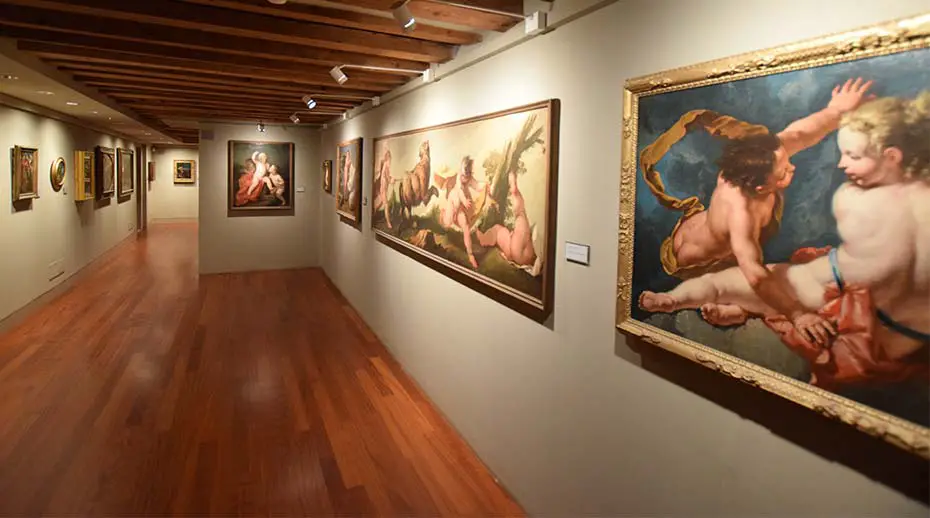 Egidio Martini (1919-2011), painter, restorer and art critic, donates his collection of works to Ca' Rezzonico; in these rooms the signatures are of boundless importance to understand the Venetian painting of the seventeenth and eighteenth centuries. But the authors exposed also cross over into the previous centuries composing a collection admired by contemporary scholars, critics and scholars, who suggested to Martini the gift to the city of Venice. Ferruccio Mestrovich Collection 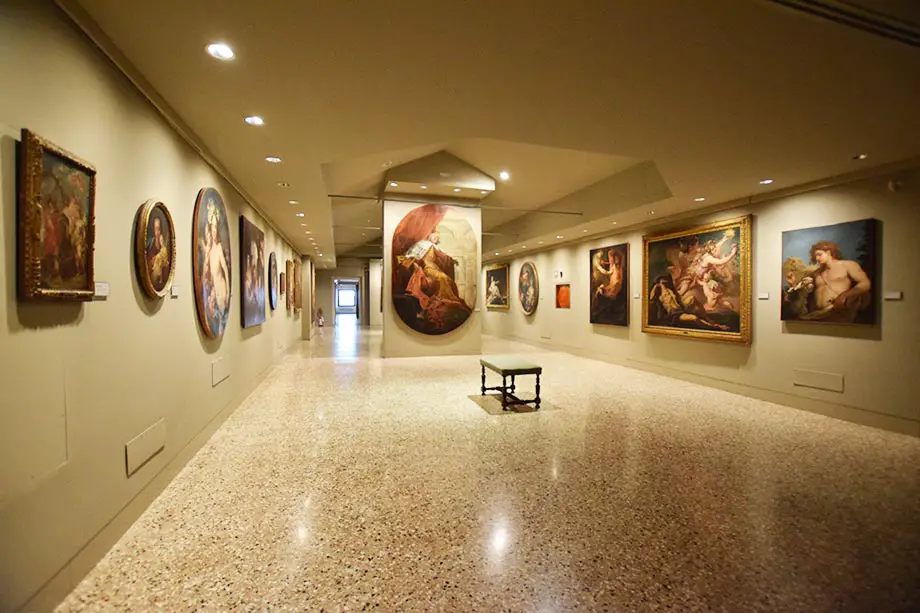 There are 29 paintings that Mestrovich, originally from Zara and persecuted during the Second World War, donated to Venice in 2010 the works of a collection that covered three centuries of painting as long as it ended in the Browning Mezzanine of Ca 'Rezzonico. Here are exhibited works by Benedetto Carpaccio (1500-1560) son of Vittore, Jacopo Tintoretto, Francesco Guardi, Diana, Alessandro Longhi (1733-1813) son of Pietro, and many other representatives of Venetian painting that border up to the threshold of the early twentieth century with Emma Ciardi (1879-1933). History The construction of the palace began in 1649 on commission of the patrician family of the Bon who commissioned the architect Baldassarre Longhena who began the work without being able to complete it due to the death of his client. In the following century a family of bankers, the Della Torre-Rezzonico coming from Rezzonico on Lake Como, who had bought the noble title in Venice and was in search of visibility in the Venetian society of the time, acquired the palace in 1751 and entrusted to Giorgio Massari completion of the work. Thanks to the rich patronage conjugated to the Rezzonico ambition the project was completed in just 5 years. Massari substantially respected the Longhena project for what concerned the fa�ade on the Grand Canal, but took up all the interior space, with the construction of the grand staircase and the ballroom, and in the pedestrian entrance behind it. Once the palace was finished it was the turn of the painters: they were called to intervene on the walls of Palazzo Rezzonico Giambattista Crosato, Giambattista Tiepolo, Jacopo Guarana and Gaspare Diziani. A few years later Carlo Rezzonico, bishop of Padua, was elected pope with the name of Clement XIII. The event marked the apex of the power of the Rezzonico who, after years of memorable feasts, became extinct at the beginning of the nineteenth century giving rise to the beginning of the decadence of Ca 'Rezzonico who went to the interior spoliation for fragmentation of the heritage artistic among the heirs and consequent dispersion. It was also decided to sell to the English poet and writer Robert Browning first, and to Count Lionello Hirschell de Minerbi then. Only in 1935 the City of Venice managed to get hold of the fund and, the following year, opened the Museo del Settecento Veneziano. Architecture The Palace has a monumental stone facade of three orders that overlooks the Grand Canal. The first of these has decoration in ashlar. The interior is equally monumental in the vastness of the entrance hall that overlooks the Grand Canal, in the grand staircase that leads to the remarkable Sala delle Feste, both designed by Giorgio Massari for the Rezzonico family. How to reach the Ca' Rezzonico Museum The Ca' Rezzonico Museum is located near Campo San Barnaba in Dorsoduro but has a vaporetto stop, which takes its name, right in front of the building. From Piazza San Marco, from Rialto, from the Railway Station and from Piazzale Roma, take line 1 with Ca' Rezzonico stop. Watch the Video by Venice Civic Museums of Ca' Rezzonico Museum
|
|||||||||||||||||
| Hours: from April 1st to October 31st from 10.00am to 6.00pm (admission allowed until 5.00pm); from November 1st to March 31st from 10.00am to 5.00pm (admission allowed until 4.00pm). Closed on December 25th, January 1st and May 1st.
Admission: full � 10; reduced � 7.50 (children from 6 to 14 years, chaperons (max 2) of groups of young people, students from 15 to 29 years, chaperons (maximum 2) of student groups, EU citizens over sixty-five, staff * of the Ministry for Cultural Heritage and Activities, holders of Rolling Venice Card * a document is required). Free for residents born in the Municipality of Venice; I.C.O.M. members; children from 0 to 5 years; handicapped people with a companion; licensed guides and tourist interpreters accompanying groups or individual visitors; for each group of at least 15 people, 1 free entry (only with reservation); volunteers of the Civil Service; ordinary MUVE partners; MUVE Friend Card holders. School offer: � 4 per person (valid for the period from 1 September to 15 March) for classes of students of all levels, accompanied by their teachers, with a list of the names compiled by the institution to which they belong. Accessibility: fully accessible for the disabled. Website: Museo Ca' Rezzonico |
|||||||||||||||||